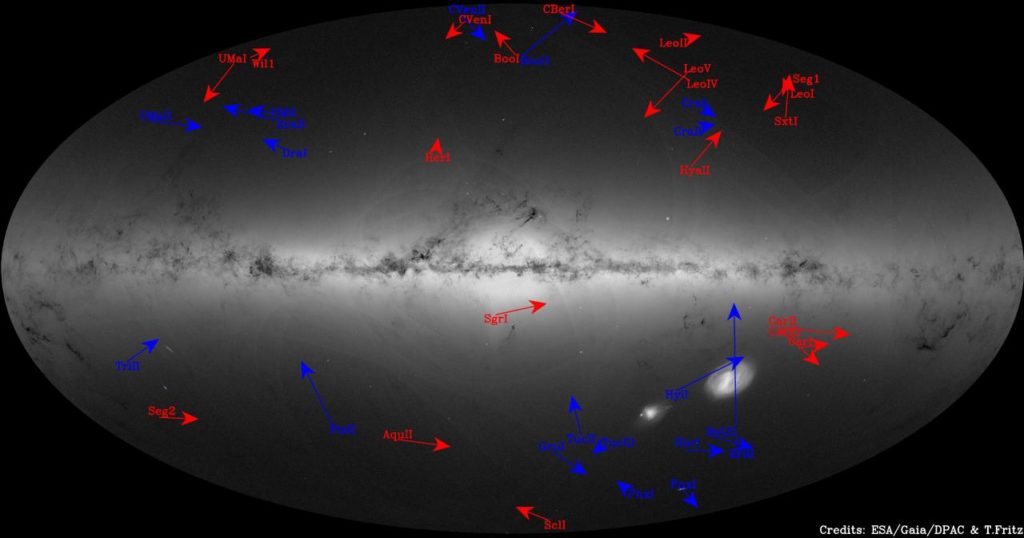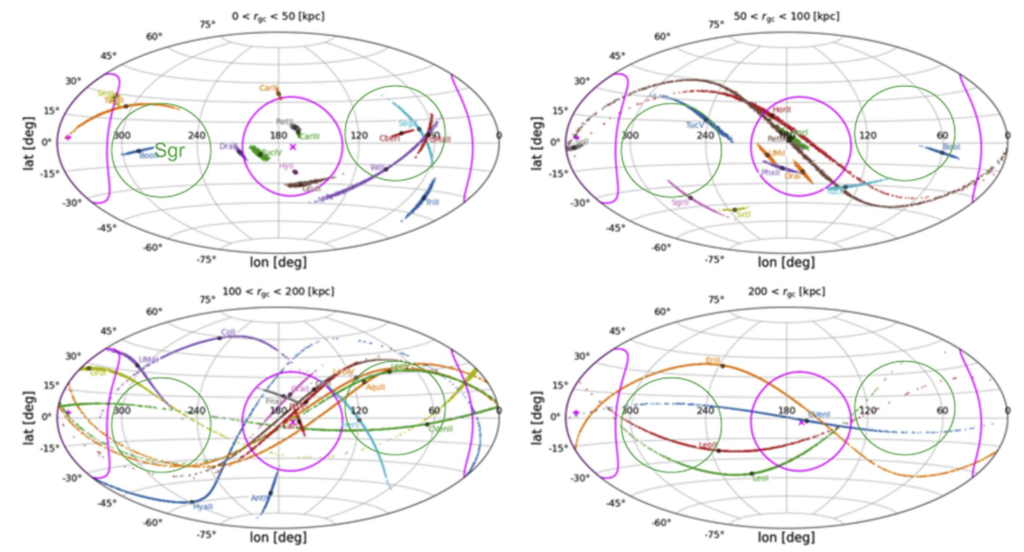Are the dwarf galaxies around the Milky Way actual satellites?
I think I am not assuming much if I say that we are all familiar with the concept of satellite. But just in case, I should say that a satellite, within an astronomical context, is an entity in orbit around a larger body. For example, the Earth’s companion in our journey through the Milky Way is the Moon, the natural satellite that orbits the Earth and that has inspired poets throughout History. But not only natural satellites orbit the Earth, also a myriad of human-made artifacts are orbiting around us, allowing communication or helping us find that amazing restaurant with such good reviews on the Internet. But these are just a few examples that can be found in our vicinity. In Astronomy, the concept of satellite abounds. We have moons orbiting other planets, planets orbiting other stars, even galaxies (vast conglomerates of stars, gas, dust, planets, etc.) orbiting other galaxies. In fact, our own Galaxy, the Milky Way, has got more than 50 satellite dwarf galaxies… or has it?
The catch comes when we properly dissect the concept of satellite. For an object to be considered the satellite of another, it needs to be in orbit. In other words, a satellite should present a coherent movement around another body that is repeated over time. In the case of artificial satellites this is “easy”, we can place an object in the correct place and at the right velocity and leave gravity do the rest. However, a natural satellite (such as the Moon, or the dwarf galaxies we are interested in) requires time and several interactions to get to the precise configuration of equilibrium that would make such an object a satellite.

For decades, since the discovery of the dwarf galaxies around the Milky Way, astronomers assumed that they were proper satellite galaxies, and thus, have been in orbit around our Galaxy for billions of years (see figure 1). This assumption has profound implications. Scientists have been characterising the orbits of these galaxies to infer, not only how massive our Galaxy is, but also how its mass is distributed in space. This is a piece of information of vital importance to unveil the past history of the Milky Way, how it was formed, and how it evolves. Unfortunately, this determination, together with the knowledge that we have acquired from it, will be under scrutiny if we discover that the dwarfs around the Milky Way are not really satellites, i.e. that they have not been there for billions of years.
The Large Magellanic Cloud (LMC), a massive dwarf galaxy that can be observed with the naked eye from the Southern Hemisphere, was the first dwarf galaxy whose satellite condition was questioned. Astronomers in the early 2010s, making use of the Hubble Space Telescope and with the aid of powerful dynamical modelling, precisely characterised the motion of the LMC as a whole 1. They found that it was impossible to reconcile how fast the LMC was moving with its mass with the fact that it was in a stable orbit around our Galaxy. Something made no sense, and the scientists concluded that the LMC could not be in a stable orbit: it was a newcomer, falling towards the Milky Way for the first time now. Are Milky Way dwarfs long-lived satellites or are most of them at first passage as the LMC? To answer this question, we need more and better data: Gaia.
The Gaia Space Mission is carrying out the most complete census of stars in our Galaxy ever made, characterising how they emit light and how they move around the Milky Way 2 . In particular, Gaia has already provided the necessary information that is needed to fully characterise the energy and velocities in three dimensions of a sample of around 40 nearby dwarf galaxies (see figure 2). With this information in hand, a group of astronomers from France, China, and Germany tried to infer whether these galaxies are indeed satellites of our Galaxy (as long thought) or newcomers 3 . The answer was not the expected one. Most of the 40 galaxies under analysis became part of our Galaxy’s neighbourhood less than 2 billion years ago, which in astronomical terms means very recently. These findings suggest that the majority of the galaxies that we see nowadays around our Galaxy have not had enough time to reach equilibrium and thus, they are not satellites. To fully understand the implications of these results, we need to go a step further.

Some of the analysed galaxies will be able to survive the interactions with the Milky Way and will become proper Milky Way satellites. Others will be destroyed by the gravitational pull ejected by the Milky Way and violent shocks with it, being cannibalised by our Galaxy. But, what will determine the fate of such galaxies? The answer is in the amount of dark matter that they present. Dark matter, this invisible matter that astronomers only think exists because of its detectable effects, acts as glue binding together all stars composing a galaxy. The more dark matter a galaxy hosts, the more difficult it will be to destroy.
The fact that the dwarf galaxies around the Milky Way might not be satellites, not only affects our knowledge on our own Galaxy, its formation and mass distribution, but the very nature of dwarf galaxies. Up until now, we thought that all these 40 dwarf galaxies were in orbit around our Galaxy, and thus, we assumed they had enough dark matter as to survive the interactions with the Milky Way. However, we now think that this might not be the case, and thus, we cannot be certain of how much dark matter these galaxies contain. We will need to re-assess this situation and what we currently know of the galaxies in our vicinity.
The truth is that Gaia keeps updating and improving what we know about our Galaxy every day that passes. Only time will reveal what new surprises await us.
References
- N. Kallivayalil; R.P. van der Marel; G. Besla et al. (2013) “Third-epoch Magellanic Cloud Proper Motions. I. Hubble Space Telescope/WFC3 Data and Orbit Implications”, ApJ, DOI: 10.1088/0004-637X/764/2/161 Link: https://ui.adsabs.harvard.edu/abs/2013ApJ…764..161K/abstract ↩
- Gaia Collaboration; A. Brown; A. Vallenari; T. Prusti et al. (2020)“Gaia Early Data Release 3. Summary of the contents and survey properties”, A&A, DOI: 10.1051/0004-6361/202039657 Link: https://ui.adsabs.harvard.edu/abs/2021A%26A…649A…1G/abstract ↩
- F. Hammer; J. Wang et al. (2021) “Gaia EDR3 proper motions of Milky Way Dwarfs. II: Velocities, Total Energy and Angular Momentum” ApJ. DOI:10.3847/1538-4357/ac27a8. Link: https://ui.adsabs.harvard.edu/abs/2021ApJ…922…93H/abstract ↩